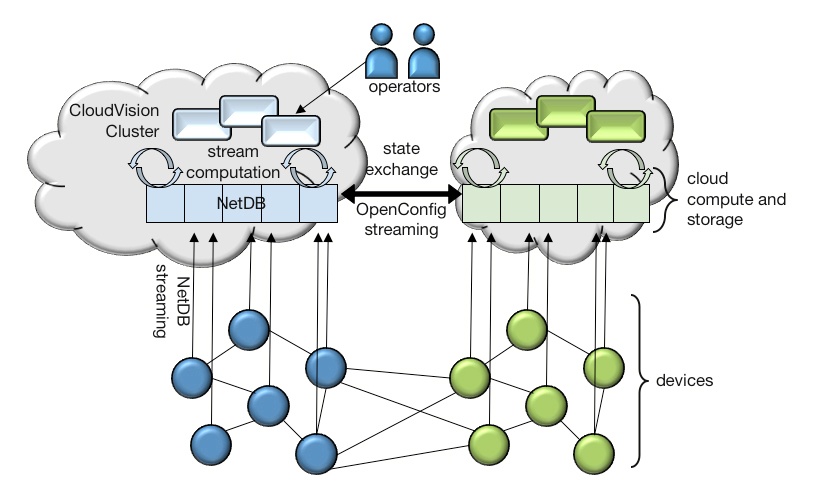Delivering Reliable AI and Cloud Networking
The explosive growth of generative AI and the demands of massive-scale cloud architectures have fundamentally redefined data center networking...

The last 40 years have seen tremendous growth and progress in the data networking industry. Ethernet, IP, MPLS, GRE, IPsec, MACsec, and VXLAN enable operators to build secure, multiservice, high-performance data planes that interoperate across multiple vendors, multiple operators, and multiple administrative domains. Likewise, BGP, OSPF, IS-IS, LDP, RSVP, BFD, LACP, L3VPN, VPLS, and EVPN enable operators to build scalable multi-vendor control planes that federate across organizational boundaries, supporting mission-critical networks with global reach.
There is a striking contrast between the maturity of the data and control planes on the one hand, and the void at the management plane on the other. What do vendors provide operators in the management plane? There are command-line interfaces designed for manual device-by-device operation; low-performance SNMP access to a small subset of device state; and a hodgepodge of proprietary programmatic interfaces involving custom engineering work to harness. The world's most sophisticated operators invest hundreds of millions of dollars to build a proper management plane from this primitive starting point. That approach is out of reach for the vast majority of operators, who simply cope without a proper management plane, scripting the most common tasks but doing most work manually. This approach is labor intensive, but worse, it's fundamentally error-prone, leading to a situation where the most common cause of service disruption is operator error. Surely the industry can do better.
At Arista, we believe we see a path forward. We have created CloudVision®, the industry's first cognitive management plane (CMP) cluster, what we hope will be a new industry-wide approach to network management. CloudVision harnesses the capabilities of cloud computing, big data and machine learning, collecting and archiving all network state over all time, and running a suite of applications providing visibility, automating deployment, and reporting and analyzing important events. CloudVision brings the benefits of custom in-house NMS at much lower cost and with much broader applicability across the operator community.
The CloudVision architecture is shown in the figure below.

The CloudVision cluster is a horizontally scalable pod of compute and storage with three layers of software: NetDB state storage (built on Kafka and HBase), stream computation and applications. Devices export all state via NetDB streaming (gNMI Notification messages over gRPC) to NetDB, capturing all device state over all time. As state enters NetDB, stream processors transform, clean, aggregate and analyze the state, writing derived state back into NetDB. Applications access the state, providing visibility and alerting, enabling the manager to take specific actions to change policy, reconfigure, upgrade, etc., and providing higher-level management applications to enable operators to apply policies uniformly across hundreds or thousands of network nodes.
The cognitive management plane architecture scales via multiple CMP clusters (CloudVision instances), where each cluster manages a subset of devices, typically based on vendor, geographic region, and/or administrative domain. Managed devices and CMP cluster software typically come from the same vendor (e.g., CloudVision for Arista switches), ingesting all device state in a mix of standardized and proprietary representations. Via stream computation, the CMP cluster transforms vendor-specific representations into well-standardized models, which may then be exported to CMP clusters for other vendors via OpenConfig streaming. In this way, one vendor's application can interact with state from devices from many vendors, providing end-to-end visibility and uniform policy control across multiple geographies, multiple vendors and multiple administrative domains.
The CMP architecture contemplates many possible deployment models. CMP clusters can run on-prem (in the operator's datacenter) or off-prem (in the cloud). They can be single-tenant or multi-tenant. They can be operated by the network operator or by the vendor. We expect that smaller operators are more likely to prefer cost-effective cloud-hosted multi-tenant deployments; the most sophisticated operators will operate their own on-prem CMP clusters.
The cognitive management plane is very powerful. It provides:
Arista is committed both to making CloudVision the industry's best network management system, and also to making the multivendor CMP vision a reality. As more customers experience CloudVision, we are hoping to generate the kind of operator pull that will convince other equipment vendors that it is in their interest (as well as in the operator's and industry's interests) to cooperate in creating the tools and building blocks that operators need to create a multi-vendor cognitive management plane.

The explosive growth of generative AI and the demands of massive-scale cloud architectures have fundamentally redefined data center networking...
/Images%20(Marketing%20Only)/Blog/VESPA-Launch-Blog.jpg)
The modern enterprise is navigating a profound transformation. The shift to the 'all wireless office' and 'coffee shop type networking', fueled by...

Data centers have evolved into highly distributed, hybrid ecosystems that span private clouds, public clouds, and colocation facilities. This...